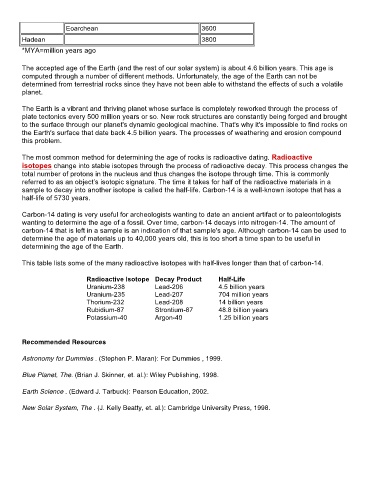Page 330 - ABCTE Study Guide_Neat
P. 330
Eoarchean 3600
Hadean 3800
*MYA=million years ago
The accepted age of the Earth (and the rest of our solar system) is about 4.6 billion years. This age is
computed through a number of different methods. Unfortunately, the age of the Earth can not be
determined from terrestrial rocks since they have not been able to withstand the effects of such a volatile
planet.
The Earth is a vibrant and thriving planet whose surface is completely reworked through the process of
plate tectonics every 500 million years or so. New rock structures are constantly being forged and brought
to the surface through our planet's dynamic geological machine. That's why it's impossible to find rocks on
the Earth's surface that date back 4.5 billion years. The processes of weathering and erosion compound
this problem.
The most common method for determining the age of rocks is radioactive dating. Radioactive
isotopes change into stable isotopes through the process of radioactive decay. This process changes the
total number of protons in the nucleus and thus changes the isotope through time. This is commonly
referred to as an object’s isotopic signature. The time it takes for half of the radioactive materials in a
sample to decay into another isotope is called the half-life. Carbon-14 is a well-known isotope that has a
half-life of 5730 years.
Carbon-14 dating is very useful for archeologists wanting to date an ancient artifact or to paleontologists
wanting to determine the age of a fossil. Over time, carbon-14 decays into nitrogen-14. The amount of
carbon-14 that is left in a sample is an indication of that sample's age. Although carbon-14 can be used to
determine the age of materials up to 40,000 years old, this is too short a time span to be useful in
determining the age of the Earth.
This table lists some of the many radioactive isotopes with half-lives longer than that of carbon-14.
Radioactive Isotope Decay Product Half-Life
Uranium-238 Lead-206 4.5 billion years
Uranium-235 Lead-207 704 million years
Thorium-232 Lead-208 14 billion years
Rubidium-87 Strontium-87 48.8 billion years
Potassium-40 Argon-40 1.25 billion years
Recommended Resources
Astronomy for Dummies . (Stephen P. Maran): For Dummies , 1999.
Blue Planet, The. (Brian J. Skinner, et. al.): Wiley Publishing, 1998.
Earth Science . (Edward J. Tarbuck): Pearson Education, 2002.
New Solar System, The . (J. Kelly Beatty, et. al.): Cambridge University Press, 1998.

